Moderate overlap front: original test
Rating applies to 2008-09 models
Tested vehicle: 2008 Saturn VUE XE 4-door 4wd
The Saturn VUE was redesigned and enlarged for the 2008 model year. Its size and weight have increased sufficiently to reclassify it as a midsize SUV (2002-07 models were classified as small SUVs.) Frontal ratings are assigned by the Institute based on a test conducted by General Motors.
| Evaluation criteria | Rating |
|---|---|
| Overall evaluation | |
| Structure and safety cage | |
| Driver injury measures | |
| Head/neck | |
| Chest | |
| Leg/foot, left | |
| Leg/foot, right | |
| Driver restraints and dummy kinematics | |
Side: original test
Rating applies to 2008-09 models built after December 2007
Tested vehicle: 2008 Saturn VUE XE 4-door 4wd with standard front and rear head curtain airbags and standard front seat-mounted torso airbags
The Saturn VUE was redesigned and enlarged for the 2008 model year. Its size and weight have increased sufficiently to reclassify it as a midsize SUV (2002-07 models were classified as small SUVs).
Two tests of the VUE were conducted. In the first test, the side curtain airbag did not deploy properly, and the rear passenger dummy's head was hit by the window sill of the rear door. This impact did not produce high head injury measures, but the head protection was inadequate. In response, General Motors redesigned the side curtain airbags to ensure more rapid inflation and greater extension of the airbag next to the rear dummy's head. In the second test, the fix was successful, and the head protection rating improved to Good. The side airbag modifications apply to all 2008 and later models manufactured after December 2007. (Information about when a specific vehicle was manufactured is on the certification label typically affixed to the car on the driver door or adjacent B-pillar.)
The two vehicles are rated separately, except that the structural ratings for both vehicles are based on both tests.
| Evaluation criteria | Rating |
|---|---|
| Overall evaluation | |
| Structure and safety cage | |
| Driver injury measures | |
| Head/neck | |
| Torso | |
| Pelvis/leg | |
| Driver head protection | |
| Rear passenger injury measures | |
| Head/neck | |
| Torso | |
| Pelvis/leg | |
| Rear passenger head protection | |
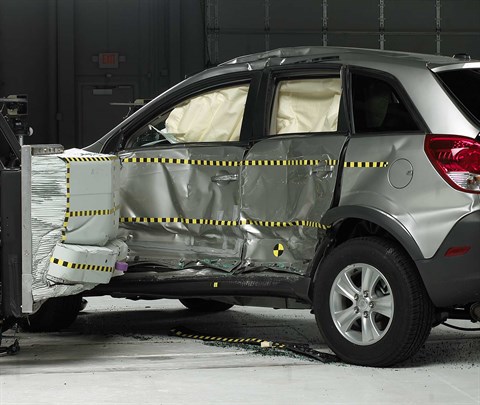
View of the vehicle and barrier just after the second of two crash tests.

View of the vehicle after the crash with doors removed, showing the side airbags and damage to the occupant compartment.

Smeared greasepaint shows where the driver dummy's head was protected from being hit by hard structures by the side curtain airbag (second test shown).
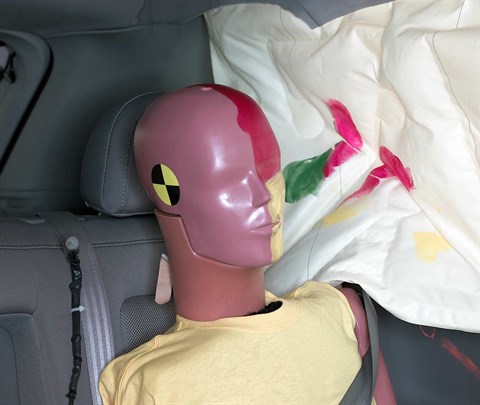
Smeared greasepaint shows where the rear passenger dummy’s head was protected by the side airbag in the second test.
Rating applies to 2008 models built before January 2008
Tested vehicle: 2008 Saturn VUE XE 4-door 4wd with standard front and rear head curtain airbags and standard front seat-mounted torso airbags
The Saturn VUE was redesigned and enlarged for the 2008 model year. Its size and weight have increased sufficiently to reclassify it as a midsize SUV (2002-07 models were classified as small SUVs).
Two tests of the VUE were conducted. In the first test, the side curtain airbag did not deploy properly, and the rear passenger dummy's head was hit by the window sill of the rear door. This impact did not produce high head injury measures, but the head protection was inadequate. In response, General Motors redesigned the side curtain airbags to ensure more rapid inflation and greater extension of the airbag next to the rear dummy's head. In the second test, the fix was successful, and the head protection rating improved to Good. The side airbag modifications apply to all 2008 and later models manufactured after December 2007. (Information about when a specific vehicle was manufactured is on the certification label typically affixed to the car on the driver door or adjacent B-pillar.)
The two vehicles are rated separately, except that the structural ratings for both vehicles are based on both tests.
| Evaluation criteria | Rating |
|---|---|
| Overall evaluation | |
| Structure and safety cage | |
| Driver injury measures | |
| Head/neck | |
| Torso | |
| Pelvis/leg | |
| Driver head protection | |
| Rear passenger injury measures | |
| Head/neck | |
| Torso | |
| Pelvis/leg | |
| Rear passenger head protection The side curtain airbag did not deploy properly, and the dummy's head was hit by the window sill of the rear passenger door. This impact did not produce high head injury measures, but the head protection is inadequate. | |
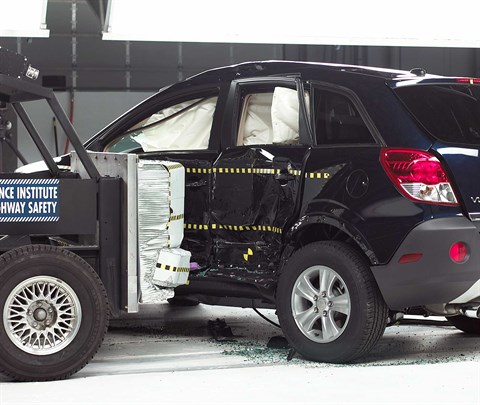
View of the vehicle and barrier just after the first of two crash tests.
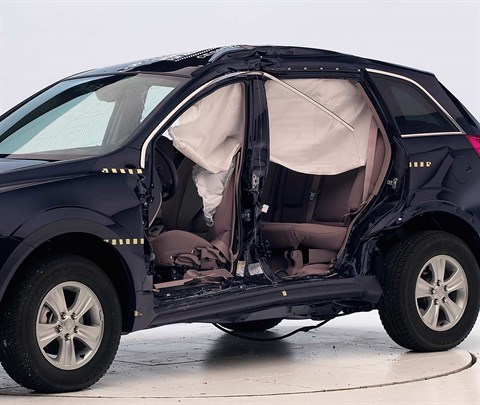
View of the vehicle after the crash with doors removed, showing the side airbags and damage to the occupant compartment.
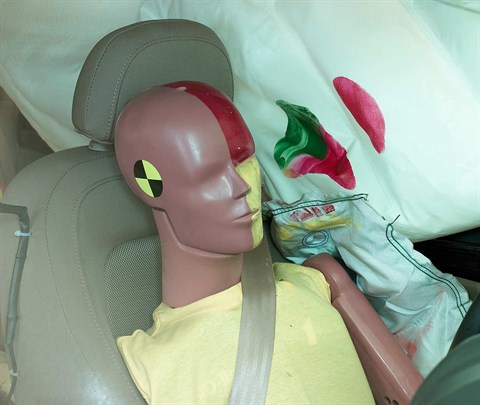
Smeared greasepaint shows where the driver dummy's head was protected from being hit by hard structures by the side airbags (first test shown).
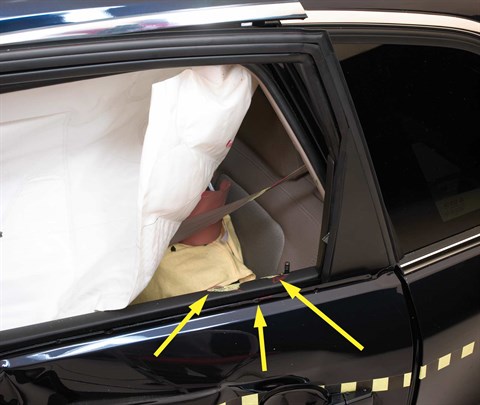
In the first test, the side curtain airbag failed to cover the entire window opening, and smeared yellow and red greasepaint shows that the dummy's head was hit by the window sill (photo taken before rear door removed).
Head restraints & seats
Seat type: Manual cloth seats AHR
| Overall evaluation | |
|---|---|
| Dynamic rating | |
| Seat/head restraint geometry |
About the head restraint & seat test
Currently, IIHS tests apply only to front seats.
